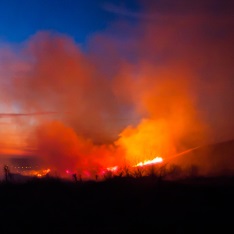VIEWPOINT: Anglia Ruskin expert looks at why these fires are becoming more common
by Fabrizio Manco, Anglia Ruskin University
The army has been called in to help firefighters deal with a huge wildfire on Saddleworth Moor, Greater Manchester, where residents have been forced to evacuate. Wildfires are also blazing across Northern California while the issue of bushfires in Australia calls for constant vigilance from the emergency services there. These fires are becoming more common and one of the reasons for this is climate change.
Warmer temperatures in the summer and associated drier conditions desiccate plant materials and create more vegetation litter, providing more fuel for these fires. Several studies have linked the increase of wildfires with climate change in various parts of the world, such as North America and Southern Europe.
For example, a study in California from 2004 modelled that the warmer and windier weather (brought about by an atmosphere with higher levels of CO2) produced fires that burned more intensely and spread faster in most locations.
It has also been demonstrated that increases in rainfall during winter and spring – which are also known consequences of climate change – provide more favourable conditions for plant growth and therefore more potential fuel for the fires later in the summer.
Even though climate change increases the vulnerability of dry environments to wildfires, a source of ignition is still required. In the UK, it can be natural (such as bolts of lightning) or caused by man either deliberately or accidentally. Various studies have shown that the number of recreational visits to “risky” sites, such as the English Peak District, increase the occurrence of wildfire.
Human activities have shaped heathlands and moorlands in the UK over the centuries, keeping them open and slowing down the natural succession towards more closed forest habitats. Despite the human impact on their origin, moorlands represent important ecosystems for numerous endangered species including reptiles, insects and birds.
Moorland management
But historic poor management has caused a lot of damage in moorland habitats. The introduction of non-native species for the moor, such as Rhododendron or planted conifers, has affected biodiversity. Overgrazing and drainage has increased the risks of erosion and flooding by reducing vegetation cover and limiting the ability for the soil to absorb precipitations. This, in turn, can lead to an increase in aridity of the habitat – which is the perfect environment for wildfires.
Nowadays, most of the UK’s moorlands are associated with red grouse shooting and are managed in relation to that activity. Procedures include rotational burning and control of predators. Some of these processes are controversial with some environmentalists claiming it can turn the moorland into a “monoculture” of low heather which can be highly susceptible to wildfires. But the evidence on this is not clear and a report by the RSPB found little proof of the negative effect of grouse moor management on biodiversity, flooding and wildfires.
The ecological role of fire
Landscapes and their plant and animal communities are not fixed in time. They are under the influence of dynamic processes that can be recurrent (such as marine tides and seasonal flooding) or catastrophic (volcanic eruptions or storms). Fire – whether natural or man-made – is an important factor that will drive the structure and wildlife composition of ecosystems.
Some areas, such as the Mediterranean region or the African savannah, have been shaped by fire for thousands of years. Plants and animals have evolved to cope with the periodic perturbations due to it. For example, some seeds can only germinate after they have been burnt.
There are even some plants and animals that are contributing in the propagation of wildfires. In Australia, some raptor birds have been observed picking up burning sticks and dropping them in unburned areas to force potential prey out of their burrows.
Despite its destructive power, fire is an important ecological process that can benefit several endangered species by maintaining their habitat. It is an important tool in the management and preservation of heathlands and moorlands in the UK when used appropriately and in a controlled way.
![]() But climate change and human activities increase the vulnerability of those habitats to uncontrolled wildfires and higher population densities near these areas will potentially put more people and houses at risk. In addition to the global battle against climate change, appropriate management procedures are necessary to maintain those habitats and ensure the risks of uncontrolled fires are minimised and the potential spread of them reduced.
But climate change and human activities increase the vulnerability of those habitats to uncontrolled wildfires and higher population densities near these areas will potentially put more people and houses at risk. In addition to the global battle against climate change, appropriate management procedures are necessary to maintain those habitats and ensure the risks of uncontrolled fires are minimised and the potential spread of them reduced.
Fabrizio Manco, Senior Lecturer in GIS and Ecology, Anglia Ruskin University




